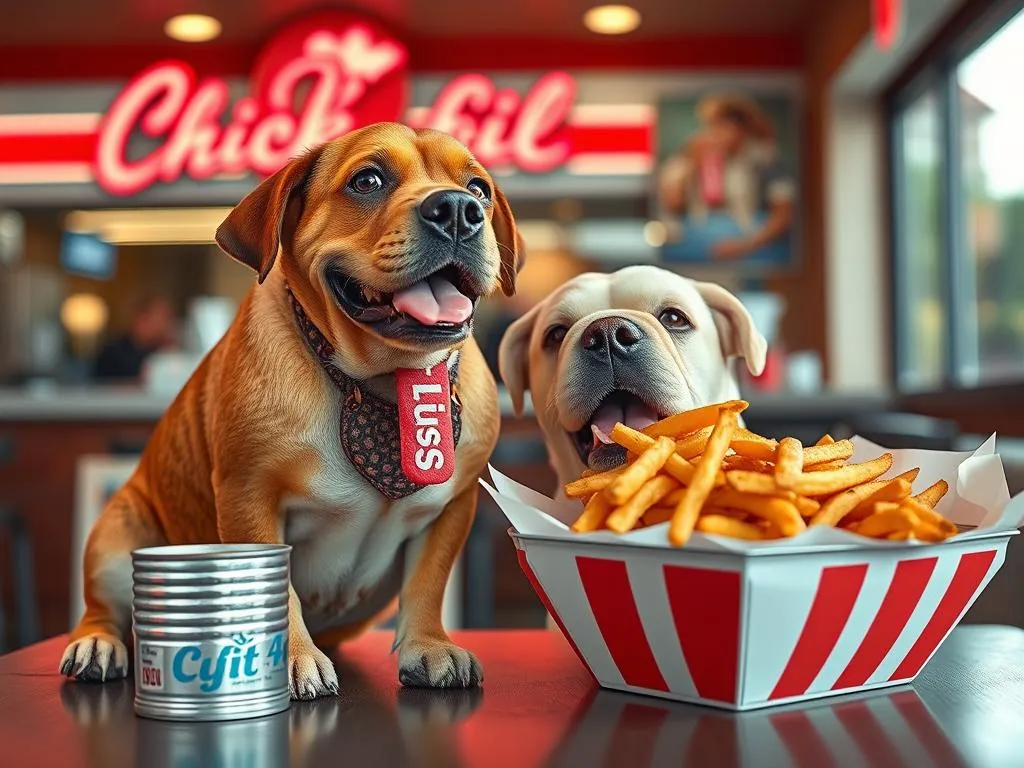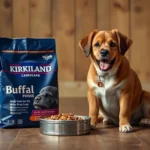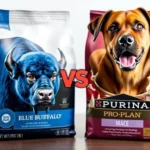
Understanding what our furry friends can and cannot eat is paramount for their health and well-being. As pet owners increasingly share their meals with their dogs, the question arises: Can dogs eat Chick-fil-A? This article delves into the intricacies of dog nutrition, examines Chick-fil-A’s menu offerings, and provides insights into the safety of sharing these popular fast-food items with our canine companions.
Understanding Dog Nutrition
Importance of Balanced Diet for Dogs
A balanced diet is crucial for maintaining a dog’s overall health. Dogs require a combination of essential nutrients, including:
- Proteins: Necessary for growth, repair, and energy.
- Fats: Provide essential fatty acids and help with the absorption of fat-soluble vitamins.
- Carbohydrates: Offer energy and aid in digestion.
- Vitamins: Support various bodily functions.
- Minerals: Essential for bone health and various metabolic processes.
Feeding a balanced diet ensures that dogs have the energy to play, maintain a healthy weight, and support their immune system.
Common Nutritional Deficiencies in Dogs
Nutritional deficiencies can lead to serious health issues. Common deficiencies in dogs may include:
- Protein deficiency: Can lead to muscle wasting and a weakened immune system.
- Fatty acid deficiency: May cause skin issues and a dull coat.
- Vitamin deficiencies: Symptoms can vary widely, such as poor growth, dental problems, and lethargy.
Recognizing signs of nutritional deficiencies is essential for timely intervention. Regular veterinary check-ups can help ensure that your dog’s diet meets their nutritional needs.
Differences Between Human and Dog Nutrition
Dogs have different digestive systems compared to humans, which means they process certain foods differently. While some human foods are safe and even beneficial for dogs, others can be harmful or toxic. For example, dogs can digest proteins and fats well, but their ability to handle certain carbohydrates, sugars, and seasonings is limited.
Overview of Chick-fil-A Menu Items
Popular Chick-fil-A Menu Options
Chick-fil-A is famous for its delicious chicken offerings. Some popular items include:
- Chicken Sandwiches: Fried or grilled chicken served on a bun.
- Nuggets: Bite-sized pieces of fried chicken.
- Fries: Waffle-cut fries, a staple side item.
- Sauces: A variety of sauces, including BBQ, Honey Mustard, and Ranch.
Nutritional Content of Chick-fil-A Foods
While Chick-fil-A meals are tasty, they are often high in calories, sodium, and unhealthy fats. Here’s a brief breakdown of some popular items:
| Menu Item | Calories | Total Fat | Sodium |
|---|---|---|---|
| Chicken Sandwich (fried) | 440 | 20g | 1,400mg |
| Grilled Chicken Sandwich | 320 | 6g | 1,500mg |
| Nuggets (8-count) | 260 | 13g | 1,100mg |
| Waffle Fries (medium) | 400 | 24g | 310mg |
These values highlight that even seemingly simple meals can pack a punch in terms of unhealthy ingredients.
Can Dogs Eat Chick-fil-A?
Safety of Chick-fil-A Ingredients for Dogs
When considering if dogs can eat Chick-fil-A, it’s essential to analyze the ingredients. Most of Chick-fil-A’s offerings contain chicken, but the preparation method and accompanying ingredients matter significantly.
- Grilled Chicken: Generally safe for dogs in moderation.
- Fried Chicken: Contains unhealthy fats and breading, which can upset a dog’s stomach.
- Fries: High in sodium and fats, not recommended for dogs.
Potential Risks of Feeding Chick-fil-A to Dogs
Feeding dogs Chick-fil-A comes with several risks, including:
- High Sodium Content: Many menu items contain excessive salt, which can lead to dehydration and more serious health issues.
- Unhealthy Fats: Fried foods can lead to obesity and pancreatitis in dogs.
- Additives and Preservatives: Many sauces and breadings contain ingredients that can be harmful to dogs, such as garlic and onion.
Specific Menu Items: Safe vs. Unsafe
When considering sharing Chick-fil-A with dogs, it’s vital to differentiate between safe and unsafe options:
- Safe Options:
- Plain Grilled Chicken: Remove any seasoning or sauces.
-
Plain Waffle Fries: In small amounts, though not ideal due to fat and sodium.
-
Unsafe Options:
- Fried Chicken Sandwiches: The breading and frying oil can be harmful.
- Nuggets: High in sodium and unhealthy fats.
- Sauces: Many contain ingredients like onions and garlic, which are toxic to dogs.
What to Consider Before Sharing Human Food with Dogs
Portion Control and Frequency
If you decide to share human food with your dog, moderation is key. Treats, including Chick-fil-A items, should only make up a small percentage of your dog’s overall diet. A good rule of thumb is that treats should not exceed 10% of a dog’s daily caloric intake.
Allergies and Food Sensitivities
Just like humans, dogs can have allergies and food sensitivities. Common allergens include:
- Wheat
- Soy
- Dairy
- Chicken
Always monitor your dog for any adverse reactions when introducing new foods, including fast food items.
Consulting a Veterinarian
Before making any significant changes to your dog’s diet or introducing new foods, consulting a veterinarian is crucial. They can provide personalized advice based on your dog’s specific health needs and dietary requirements.
Alternative Treats and Foods for Dogs
Healthy Dog-Friendly Foods
There are plenty of human foods that are safe and healthy for dogs. Some options include:
- Cooked lean meats: Chicken, turkey, or beef (without seasoning).
- Fruits: Apples, blueberries, and bananas (in moderation).
- Vegetables: Carrots, green beans, and sweet potatoes.
- Peanut butter: Ensure it is xylitol-free.
Homemade Dog Treat Recipes
Creating homemade dog treats can be a fun way to ensure your dog gets healthy snacks. Here are two simple recipes:
Peanut Butter Banana Treats
Ingredients:
– 1 ripe banana
– 1 cup peanut butter (xylitol-free)
– 2 cups whole wheat flour
– 1 egg
Instructions:
1. Preheat the oven to 350°F (175°C).
2. Mash the banana and mix in the peanut butter and egg.
3. Gradually add the flour until a dough forms.
4. Roll out the dough and cut into shapes.
5. Bake for 15-20 minutes or until golden brown.
Sweet Potato Chews
Ingredients:
– 1 large sweet potato
Instructions:
1. Preheat the oven to 250°F (120°C).
2. Slice the sweet potato into thin rounds.
3. Place on a baking sheet and bake for 2-3 hours, flipping halfway through.
4. Allow to cool before serving.
Commercial Dog Treat Recommendations
If you prefer store-bought options, look for treats that are:
- Made with natural ingredients
- Free from artificial additives
- Specifically formulated for dogs
Brands like Blue Buffalo, Wellness, and Zuke’s offer a range of healthy treats.
Conclusion
In conclusion, while the question Can dogs eat Chick-fil-A? may tempt many dog owners, it’s essential to weigh the risks and benefits. Some Chick-fil-A items, like plain grilled chicken, can be safe in moderation, but many popular options are not suitable due to high sodium, unhealthy fats, and harmful additives.
Prioritizing a balanced diet for your dog will ensure they stay healthy and happy. Always consult with a veterinarian before introducing new foods and consider healthier alternatives to fast food.
FAQs
Can dogs eat fried chicken?
Fried chicken is not recommended for dogs due to high fat and sodium content, which can lead to health issues.
What should I do if my dog eats Chick-fil-A?
Monitor for any signs of distress such as vomiting or diarrhea. If severe symptoms occur, contact your veterinarian.
Are there any safe sauces from Chick-fil-A for dogs?
Most sauces from Chick-fil-A contain ingredients like garlic and onion, which are toxic to dogs. It’s best to avoid all sauces.
How can I better understand my dog’s nutritional needs?
Consulting with a veterinarian or a pet nutritionist can provide personalized insights into your dog’s specific dietary requirements and health needs.
By nurturing our dogs with the right food and nutrients, we can ensure they lead a long, healthy, and happy life.









